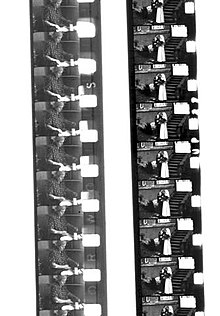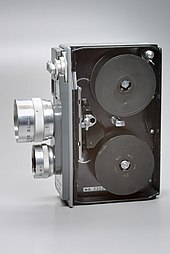Cine film
As a small film all film formats referred that are narrower than the 35 mm wide normal film . The photographic recording material is used in motion picture cameras as well as some cameras with special recording formats .
Formats and packaging
Film formats still used today are:
- Double-8 [international "Double 8", abbreviation "D-8", not to be confused with the consumer video format "Digital8"] (becomes normal 8 film after development ): width 16 mm, both film edges perforated. First half of the film is exposed, then the other half as it is returned. The image line coincides with a perforation hole. After development, the film is cut (split) lengthways into two 8 mm wide strips. Introduced in 1932, double-8 is incompatible with double-super-8, and neither is normal-8 with super-8. Two magnetic sound slopes of different widths can be applied.
- Super-8 [abbr. "S-8"]: width 8 mm, one film edge perforated , compared to normal-8 clearly smaller perforation hole. The line of the image lies between two perforation holes. Image field size: 5.46 × 4.01 mm [width × height]. Two magnetic sound slopes of different widths can be applied. Copies could also be made with light tone at times. Presented at Photokina in 1964 and at IPEX in 1965.
- Single-8 : Same dimensions as Super-8 and, after development, also compatible with Super-8 projectors without restriction, but different cassettes for other cameras and other film material. In contrast to the Super 8 cassette, this allows film rewinding or rewinding. The film pressure plate is also part of the camera. Two magnetic sound slopes of different widths can be applied; in trade since 1965.
- Double-Super-8 [international "Double-Super-8" or "DS-8"]: width 16 mm, both film edges perforated. Used like conventional double-8 film, but with super-8 perforations. Interesting possibility, like with Single-8, to avoid the technical disadvantages of the Super-8 cassette. In trade since 1966.
- 9.5 mm (Pathé baby film): width 9.525 mm. Perforation in the middle of the film. The 9.5 mm film has the greatest material utilization of all film formats (72%). Further advantages: The wide image line enables invisible gluing points. The image size and thus the resolution come close to 16 mm film. Some of the cameras are much more manageable than 16 mm devices. 2 magnetic sound tracks are possible. Copies were made with light tone at times. The 9.5 mm film was pushed into the background by the 16 mm and 8 mm formats that were introduced later and is now only widely used in France and England; it is named after the French company Pathé. On the market since December 1921 in the form of commercial copies of the Pathé baby projector. In 1922 the first Pathé baby camera appeared together with raw film.
- 16 mm : width originally ⅝ inches (15.875 mm), basic layout of the individual image 0.3 "× 0.4" [height to width] (7.62 × 10.16 mm). Initially perforated on both sides, the 16 mm film is also available with just one row of holes. Films perforated on one side can carry full-width audio tracks. Semi- professional film format used worldwide with enormous possibilities. Before the introduction of the video recorder, television programs were archived with this format, until the introduction of the professional camcorder in the 1980s, all television reports were filmed with it. Introduced in 1923.
The Super 16 film version has a larger field of view from 7.42 to 12.35 mm and no soundtrack. It is only used as a recording format. Ultra-16 is another variant of the use of the surface over almost the entire width of the film, vertically drawn back between the perforation holes.
Some cine film formats that are no longer in use today:
- Duplex / monoplex: width 9.5 mm. The film ran straight through the camera, had to be turned over, like the double-8 film, after one half had been exposed and was split after developing. A film only 4.75 mm wide was obtained. At that time the most economical film format on the market.
- Simple-8 (Straight 8): width 8 mm. To avoid flipping the half-exposed film, cameras for single-8 film came on the market in the United States in the 1930s. In 1936, AGFA produced a cassette with 10 meters of 8 mm film under the name MOVEX in Germany. Both systems could not prevail. However, the AGFA cassette later formed the model for the technically higher standing Single-8 cassette.
- 17.5 mm : There were at least four different film formats with a width of 17.5 mm. Only the French "Pathé-Rural" system was noticeably widespread. Initially silent, the copies were later given a light tone. In this way the cinema could be brought to the smallest villages. The format was not actually intended for self-recording, but a camera for it later appeared on the market.
- 28.5 mm (1⅛ "): an early home cinema format that found some circulation in France under the name" Pathé-Kok ", published in 1912.
History and Development
In 1889 Kodak produced transparent film on nitrocellulose backing, the forerunner of the later narrow films. In 1908 Kodak produced the first security film on acetate cellulose backing, Agfa in 1909. This created the conditions for the gradual abolition of the flammable nitrate film carriers.
In 1923, Kodak introduced 16mm reversal film on security backing. In 1932 Kodak brought the double-eight film, which was created by dividing 16mm film and which became more affordable for the broad amateur film market. Amateur filming became widespread. Kodak introduced the first 16 mm reversal color film to the market in 1935, and a year later it was also available as 35 mm film and 8 mm material. In 1964, Kodak introduced the then new Super 8 program and launched it in 1965.
In the 1970s, in the age before video technology , the cine film was the most popular film medium, especially for private users, but B-movies were also recorded in this film format. For the production of sound films, externally synchronized magnetic sound tapes were sometimes used, which were mechanically or electronically coupled to the cine projector.
The more recent developments include the Super-16 and Ultra-16 image formats .
Dubbing to DVD and video
Duplication of cine film was difficult and very expensive in the private sector. Today there is the possibility of copying and processing the narrow films on video or DVD.
Recording the cine film from the screen with a video camera does not lead to satisfactory results because neither the frame rate (which leads to light-dark fluctuations and blurring) nor the light intensity is the same at every point in the picture (which leads to a lighter one Center and underexposures on the edges). Professional photocopiers, just like television companies, use film scanners with single image scanning .
But the results of copiers are not always optimal and also relatively expensive. However, for the amateur who has a bit of craftsmanship and the necessary patience, there is a method that delivers very good results and is also quite inexpensive. This is the process of film digitization using a good flatbed scanner.
Very good results are achieved by direct scanning of narrow films. The films are not projected or scanned, but recorded in the film window of converted projectors. For this, the speed of the projector is modified. A special lamp with brightness control and a special lens are essential. You then get a flicker-free video without hotspot and without blurring. The camera used for this, however, must be able to capture the high contrast range of the narrow film . Otherwise the details in the light and / or dark image sectors will be lost.
literature
- Fridolin Schley : The Eighth World: fifty years of Super 8 . Edition Braus, Berlin 2014. ISBN 978-3-86228-098-8 (essay and film stills)
See also
Web links
- Contrast range of the cine film
- Super 8 cine film cameras
- Examples of Super 8 cameras
- Virtual cine film apparatus museum
- Cine magazine
- Cine 8-16 cine magazine
- super8site.com - Info page about cine film
- isuper8.de - Info page about cine film
- Photographica forum with cine film area
Individual evidence
- ^ Information sheet from KODAK AG Stuttgart-Wangen from 1965
- ↑ [1] Website: Basics of cine dubbing - studio technology. Retrieved September 16, 2018.
-


